Ladybugs—also known as ladybirds, lady beetles, or Coccinellids—are famous for their bright colors and adorable round shape. In some cultures, they’re considered lucky charms, while in agriculture, they’re hailed as vital natural pest controllers. Belonging to the beetle family Coccinellidae, these insects are widely recognized for their effectiveness in controlling aphid populations, though a few species can become crop pests themselves. In this article, you’ll discover 18 common types of ladybugs, their key characteristics, and tips for easy identification.

Small and Compact: Most measure 1–10 millimeters in length, with oval or dome-shaped bodies.
Bright and Varied Colors: Classic ladybugs are red with black spots, but they can also be yellow, orange, or even black with spots or stripes.
Two Pairs of Wings: The hard outer shell (elytra) protects a delicate pair of flight wings beneath.
Complete Metamorphosis: They go through four life stages—egg, larva, pupa, and adult.
Diet Diversity: Most are voracious predators of aphids, scale insects, and whiteflies; some feed on plants or fungi.
Warning Coloration: Their vibrant hues serve as a warning to predators about their foul taste or potential toxicity.
Chemical Defense: Some species release bitter, toxic fluids from their legs when threatened—harmless to humans but effective against predators.
Hibernate or Migrate: Many ladybugs survive cold months through hibernation or even long-distance migration.
Incredible Diversity: There are about 6,000 known species worldwide, each adapted to its own environment.
Classic red elytra with three black spots on each side and one central spot. The head is black with two white patches. Both larvae and adults are excellent aphid hunters. Widely used in Europe, Asia, and North America for biological pest control.

Almost hemispherical body, matte orange color, with about 24 black spots (sometimes more or less). Unlike most ladybugs, both adults and larvae are herbivores, feeding on soapwort and other Caryophyllaceae and legume family plants.
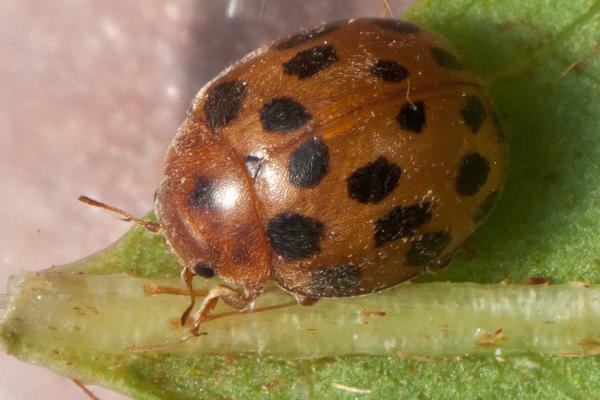
Known as the "Saint Anthony’s cow" in some regions. The most common form is red with a single large black spot on each elytron. Larvae are particularly aggressive aphid predators, capable of consuming 100 aphids per day.
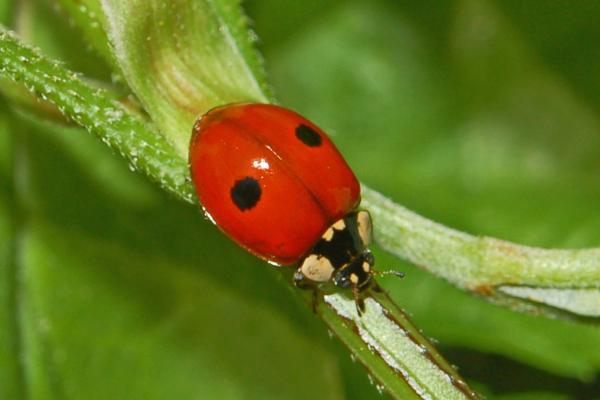
Rounded, shiny black elytra with red, comma-shaped spots. Prefers coniferous forests and high-altitude woodlands, preying mainly on aphids and scale insects.
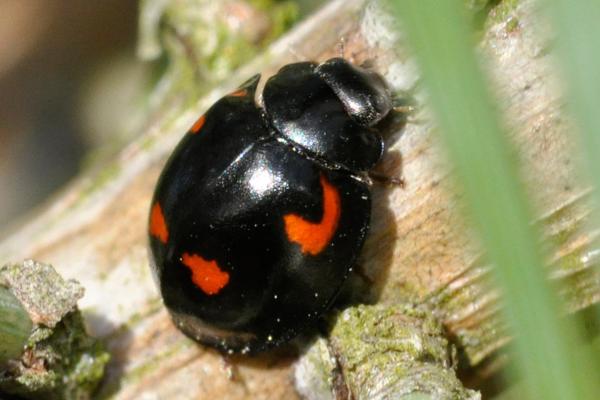
Yellow elytra with about 22 small black spots. Both adults and larvae are mycophagous, feeding on powdery mildew fungi, making them valuable allies in vineyards, tomato fields, and potato crops.
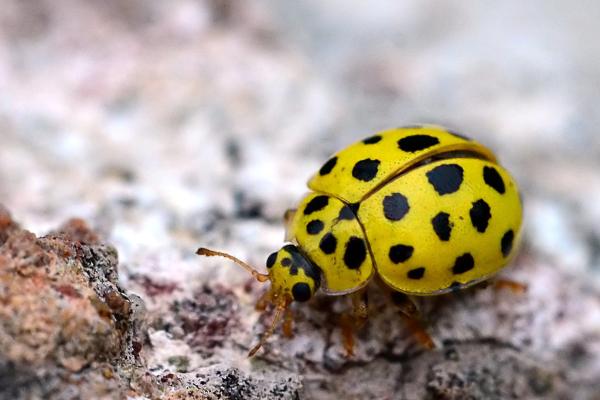
Large body size, color ranging from pale yellow-brown to bright orange-red, with 9 black spots in four horizontal lines. A notorious invasive species, it aggressively preys on aphids and scale insects but can become a pest by invading homes and outcompeting native ladybugs.
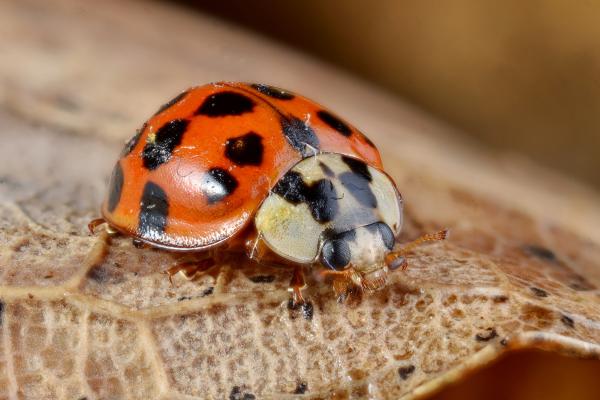
Elongated body and legs, pink-red with six black spots in four rows. Both larvae and adults feed on aphids, mites, insect eggs, small larvae, and pollen (which can comprise up to 50% of their diet).

Circular, initially bright orange turning to shiny dark brown with age. Specialized in preying on scale insects and sometimes resorts to cannibalism. Frequently found on high trees.

Semi-circular, brick-red with black spots and short, dense fuzz. Highly effective for biological control of cottony cushion scale, especially in citrus orchards.

Rare, ivory-white elytra with 8–10 distinct black spots and translucent edges. Both larvae and adults feed on powdery mildew fungi. Its lower jaws are adapted like a rake for specialized feeding.
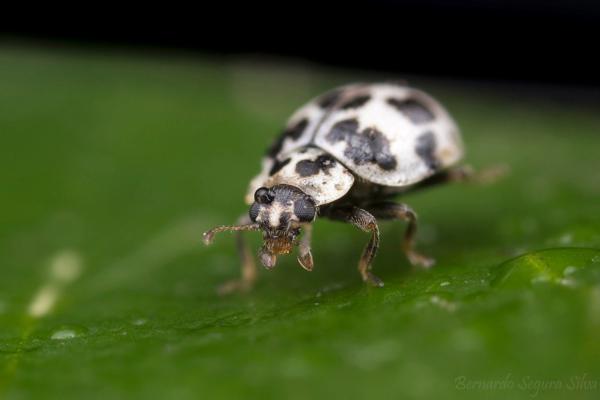
Transverse Ladybug (Coccinella transversalis)
Black Scale Predator (Exochomus nigromaculatus)
Ten-Spotted Ladybug (Adalia decempunctata)
Eleven-Spotted Ladybug (Coccinella undecimpunctata)
Striped Ladybug (Harmonia quadripunctata)
Alfalfa Ladybug (Subcoccinella vigintiquatuorpunctata)
Melon Ladybug (Henosepilachna argus)
Secretive Ladybug (Hyperaspis duvergeri)

Ladybugs are crucial allies for organic and sustainable farming, providing natural pest control and reducing the need for chemical pesticides. However, some species that feed on plants or fungi can occasionally become crop pests. Learning to recognize and conserve native beneficial ladybugs is essential for healthy agricultural ecosystems.
Bibliography
Blasco-Zumeta J. (s.f). Exochomus quadripustulatus (Coleoptera, Coccinellidae). Available at: http://monteriza.com/wp-content/uploads/insecta/220.exochomus-quadripustulatus.pdf
Chiandussi MC and Panonto SF. (s.f). Guide to home breeding of Ladybugs. Available at: https://inta.gob.ar/sites/default/files/inta_guia_para_la_cria_caera_de_coccinelidos.pdf
Coccinellidae of Argentina. Available at: https://www.coccinellidae.cl/paginasWebArg/Paginas/Biologia_Arg_01.php
Coleoptera Neotropical. Available at: http://coleoptera-neotropical.org/paginaprincipalhome.html
Eizaguirre S and López-Pérez JJ. (2012). Chorological catalog of the coccinellids (coleoptera, coccinellidae) of the province of Huelva (southwest of Andalusia, Spain). Available at: http://sea-entomologia.org/PDF/Bulletin51/143148BSEA51CoccinellidaeHuelva.pdf
Núñez Pérez EJ, Morales T and Nieto Nafría JM. (1992). Coccinellids (Col.: Coccinellidae) predators of aphids (Horn. Aphididae) on cultivated plants of León. Available at: https://entomologia.net/l_coleoptera/coccinellidae/coccin%E9lidos_y_sus_pulgones.pdf
Perales Gutiérrez MA and Arredondo HC. (1999). Seven-spotted Ladybug. Available at: https://www.gob.mx/cms/uploads/attachment/file/172897/Ficha_CB_20_Coccinella_septepunctata_L.pdf
Villacide J and Masciocchi M. (2014). "Cows of San Antonio" Adalia
animal tags: Ladybugs
We created this article in conjunction with AI technology, then made sure it was fact-checked and edited by a Animals Top editor.